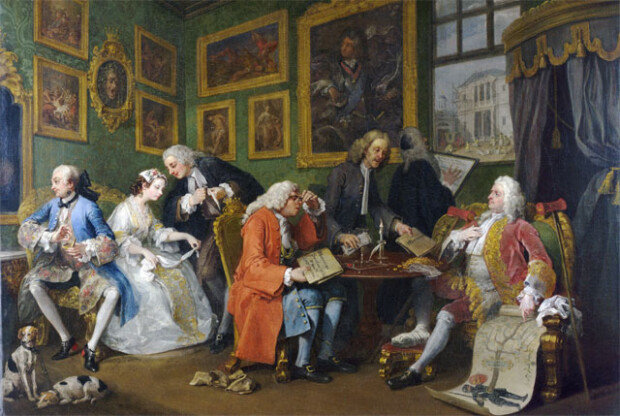'Marriage A-la-Mode'
'Marriage A-la-Mode'
Posted February. 21, 2019 07:42,
Updated February. 21, 2019 07:42

Satire and humor can exist when there is insight to observe social phenomenon. One of the 18th century's most influential artists, William Hogarth was a pictorial satirist. He was exceptionally talented in expressing humor in moral themes. "Marriage A-la-Mode" paintings, a series of six pictures painted by the British painter, satirize immoral marriages of the British upper class.
The paintings depict of a marriage between the offspring of a bankrupt earl and a wealthy merchant seeking to up climb up the social ladder. The earl sitting on the right side of the table points a finger at his family tree, proudly showing off his family. The merchant sitting across from the earl is checking a contract with his spectacles on. The broker is handing the dowry and contract to the earl. There are heaps of golden coins on the table.
In the Marriage A-la-Mode paintings, the bride and groom appear to have no interest in each other. The groom, adorned in a blue coat, is admiring his own reflection, while the bride is intently listening to her attorney, who later becomes her lover. The expensive paintings and lavish furnishings of the house and the half-way built, fancy house that is shown out of the window suggest why the earl has gone bankrupt. Through this marriage, the merchant wanted to achieve his dream to become upper class and the earl must have hoped to settle his most pending financial issues.
What happened to the couple after the marriage? In conclusion, the couple fell apart right after the marriage. The groom gets syphilis and gets killed by a knife after witnessing the extramarital affair between his wife and the attorney, who is sentenced to death for homicide. The bride commits suicide by drinking poison. The paintings are a pungent satire of the immorality of the upper class at the time. One may wonder, however, whether the marriage of convenience, extramarital affairs, homicide, suicide and other provocative features of the old times are truly irrelevant with modern times?







